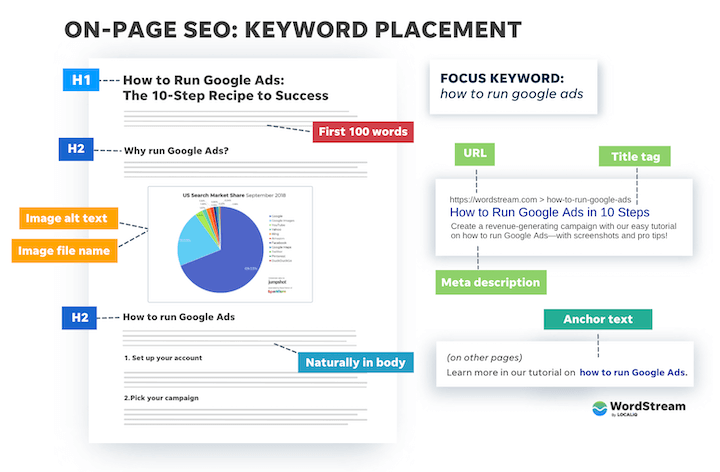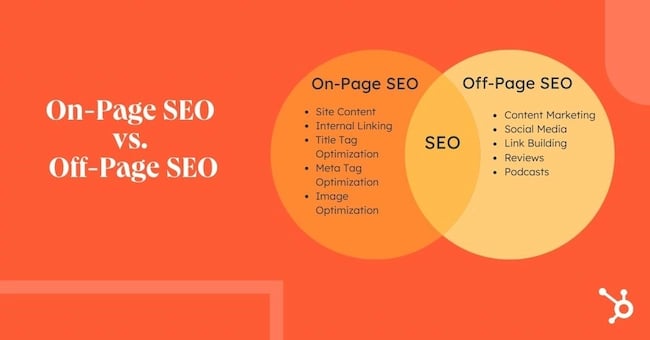Unlock the secrets to boost your website’s ranking with this comprehensive On-Page SEO Checklist – don’t miss out on success!

Image courtesy of via DALL-E 3
Table of Contents
Have you ever wondered how websites appear when you search for something on the internet? That’s where SEO comes in! SEO stands for Search Engine Optimization, and it helps websites like yours show up higher in search results. In this guide, we’ll focus on ‘on-page SEO,’ which is all about optimizing your website’s content to rank better in search engines.
What is SEO?
SEO, or Search Engine Optimization, is like a magic recipe that helps search engines like Google understand what your website is all about. By using the right ingredients, like keywords and meta tags, you can make sure your website pops up when people search for things related to what you offer.
Why is On-Page SEO Important?
On-page SEO is crucial because it tells search engines why your website deserves to be seen by more people. When you do on-page SEO right, you increase your chances of showing up at the top of search results. This means more visitors to your website, more customers for your business, and more success overall!
Keyword Research
When it comes to optimizing your website for higher rankings, one crucial step is conducting keyword research. Understanding the basics of keywords and how to use them effectively can significantly impact your on-page SEO. Let’s delve into this essential aspect of website optimization.
Finding the Right Keywords
Keywords are the words or phrases that people type into search engines to find information. Choosing the right keywords for your website is vital because it helps search engines understand what your content is about, leading to better visibility in search results. To find the best keywords for your site, think about what your target audience might search for when looking for your products or services. Consider using specific terms related to your industry or niche to attract the right visitors to your site.
Tools for Keyword Research
Fortunately, there are tools available to help you with keyword research. Platforms like Google Keyword Planner, SEMrush, and Ahrefs offer valuable insights into search volume, competition, and related keywords. These tools can guide you in choosing the most relevant and high-traffic keywords for your website. By utilizing these resources, you can optimize your content with the words that your potential customers are actively searching for, boosting your chances of ranking higher in search engine results.
Title Tags and Meta Descriptions
Title tags are like the titles of chapters in a book. They tell search engines and readers what a specific webpage is about. Title tags show up as the clickable headline in search engine results, so it’s essential to create them wisely. A good title tag can attract more people to click on your website!
Creating Effective Meta Descriptions
Now that we know about title tags, let’s talk about meta descriptions. Meta descriptions are short summaries that appear under the title tag in search results. They give searchers a sneak peek into what they can expect on your webpage. Writing compelling meta descriptions can increase the chances of people clicking on your website. So, make sure to craft engaging descriptions that make readers curious!
Content Quality and Relevance
When it comes to creating content for your website, quality is key. High-quality content is well-written, informative, and engaging for your audience. Not only does good content help keep visitors on your site longer, but it also signals to search engines that your website is a valuable resource worth ranking higher in search results.
Image courtesy of blog.hubspot.com via Google Images
Keeping Content Relevant
Relevance is another crucial aspect of on-page SEO. It’s not just about having quality content; it’s also about keeping that content up-to-date and relevant to your audience’s needs. Search engines favor websites that continually update their content to ensure it stays fresh and valuable. Regularly reviewing and refreshing your content can help boost your website’s visibility and improve its rankings over time.
Header Tags
Header tags play a crucial role in organizing and structuring your website content for better SEO. These tags, including H1, H2, H3, and so on, help search engines understand the hierarchy and importance of different sections on a webpage. Let’s dive into what header tags are all about!
Understanding Header Tags
Header tags are like the titles of different sections within a book. The H1 tag is typically reserved for the main title of the page and should include your primary keyword. Subheadings, such as H2 and H3 tags, break down the content further into smaller, more digestible pieces. Search engines use these tags to determine the structure and relevance of your content, so using them correctly is essential for SEO.
Best Practices for Using Header Tags
To make the most out of header tags, follow these best practices:
1. Use only one H1 tag per page, and make sure it accurately describes the content of the page.
2. Utilize H2 and H3 tags to break down your content into logical sections. This helps both users and search engines navigate your page more easily.
3. Include relevant keywords in your header tags to signal to search engines what the content is about.
4. Ensure your header tags are consistent across your website for a cohesive structure.
By implementing these practices, you can improve the organization of your content, making it more user-friendly and SEO-friendly at the same time.
Image Optimization
Images play a crucial role in making your website visually appealing and engaging for visitors. However, did you know that optimizing images can also impact your website’s rankings on search engines like Google? Let’s delve into the world of image optimization and learn how to make your website more SEO-friendly.

Image courtesy of www.wordstream.com via Google Images
Using Alt Text
Alt text, also known as alternative text, is a brief description of an image that is displayed when the image fails to load on a webpage. Search engines use alt text to understand the content of the image, making it an essential element for SEO. When adding alt text to your images, be descriptive and use relevant keywords to improve your website’s visibility in search results.
Optimizing Image Size
Large image files can significantly slow down your website’s loading speed, which can negatively impact user experience and SEO. To optimize your images for the web, resize them to the dimensions needed on your website and compress them without compromising on quality. By reducing the file size of your images, you can improve your website’s loading speed and enhance its overall performance.
Internal Linking
Internal linking plays a crucial role in improving your website’s navigation and SEO. Let’s dive into what internal links are and how you can create an effective internal linking structure to enhance your site’s performance.
What are Internal Links?
Internal links are hyperlinks that connect one page of a website to another page within the same website. These links help users navigate your site and establish a hierarchy for the information presented. When search engines crawl your website, they use internal links to discover and index your content, which can positively impact your SEO.
Creating an Effective Internal Linking Structure
To develop a strong internal linking strategy, consider the following tips:
1. Use descriptive anchor text: When adding internal links, use descriptive anchor text that accurately reflects the content of the linked page. This not only helps users understand where the link will take them but also provides valuable context for search engines.
2. Prioritize relevant links: Link related pages together to guide users through relevant content. This not only improves user experience but also helps search engines understand the relationship between different pages on your site.
3. Avoid overloading links: While internal links are essential, it’s crucial to maintain a balance. Too many links on a page can confuse users and dilute the impact of each link. Focus on quality over quantity.
4. Update and maintain links: Regularly review your internal links to ensure they are functional and point to relevant pages. Broken links can negatively impact user experience and SEO, so it’s essential to keep your internal linking structure up to date.
By implementing these strategies, you can create a well-organized internal linking structure that enhances your website’s usability and boosts its SEO performance.
User Experience (UX)
When it comes to user experience (UX), one crucial aspect is ensuring that your website is mobile-friendly. This means that your site should be easy to navigate and interact with on smartphones and tablets. With more and more people using mobile devices to browse the internet, it’s essential that your website functions well on these platforms.

Image courtesy of blog.hubspot.com via Google Images
Improving Loading Speed
Another key factor in providing a positive user experience is the loading speed of your website. If your site takes too long to load, visitors are likely to get frustrated and leave. To improve loading speed, you can optimize images by resizing and compressing them, reduce the number of plugins you use, and consider using a content delivery network (CDN) to help distribute your site’s content more efficiently.
Conclusion
In conclusion, mastering on-page SEO is crucial for boosting your website’s rankings and visibility on search engines. By implementing the strategies outlined in this guide, you can significantly improve your website’s performance and attract more organic traffic. Remember, search engine optimization is an ongoing process that requires dedication and effort, but the results are well worth it.
Recap of On-Page SEO
To recap, here are the key takeaways from this article:
- Understand what SEO is and why it matters for your website’s success.
- Conduct thorough keyword research to identify the right terms to target.
- Optimize title tags, meta descriptions, and header tags for better search engine visibility.
- Produce high-quality, relevant content that resonates with your target audience.
- Optimize images with descriptive alt text and optimal file sizes.
- Create an effective internal linking structure to enhance navigation and SEO.
- Focus on improving user experience by making your site mobile-friendly and optimizing loading speed.
Next Steps
If you’re looking to improve your website’s on-page SEO, here are some next steps you can take:
- Regularly update and refresh your content to keep it current and engaging for visitors.
- Monitor your website’s performance using tools like Google Analytics and Search Console to track progress.
- Stay informed about the latest SEO trends and updates to adapt your strategy accordingly.
- Consider seeking professional help from SEO experts if you need assistance with optimizing your website.
Want to turn these SEO insights into real results? Seorocket is an all-in-one AI SEO solution that uses the power of AI to analyze your competition and craft high-ranking content.
Seorocket offers a suite of powerful tools, including a Keyword Researcher to find the most profitable keywords, an AI Writer to generate unique and Google-friendly content, and an Automatic Publisher to schedule and publish your content directly to your website. Plus, you’ll get real-time performance tracking so you can see exactly what’s working and make adjustments as needed.
Stop just reading about SEO – take action with Seorocket and skyrocket your search rankings today. Sign up for a free trial and see the difference Seorocket can make for your website!
Frequently Asked Questions (FAQs)
What is the difference between on-page and off-page SEO?
On-page SEO refers to the optimization strategies implemented on the website itself, such as content quality, header tags, and image optimization, to improve its search engine ranking. Off-page SEO involves activities outside the website, like link building and social media marketing, to enhance its online presence and authority. Both on-page and off-page SEO are crucial for a comprehensive SEO strategy, as they work together to boost a website’s visibility and credibility in search results.
How often should I update my content?
Updating content regularly is essential to keep it fresh, relevant, and engaging for both users and search engines. The frequency of content updates may vary depending on the type of website and industry. As a general guideline, it’s recommended to review and refresh content periodically, especially if there are changes in your industry, new developments, or updated information that could enhance the value of your content. By consistently updating your content, you can improve its performance, relevance, and ultimately, your website’s SEO rankings.







